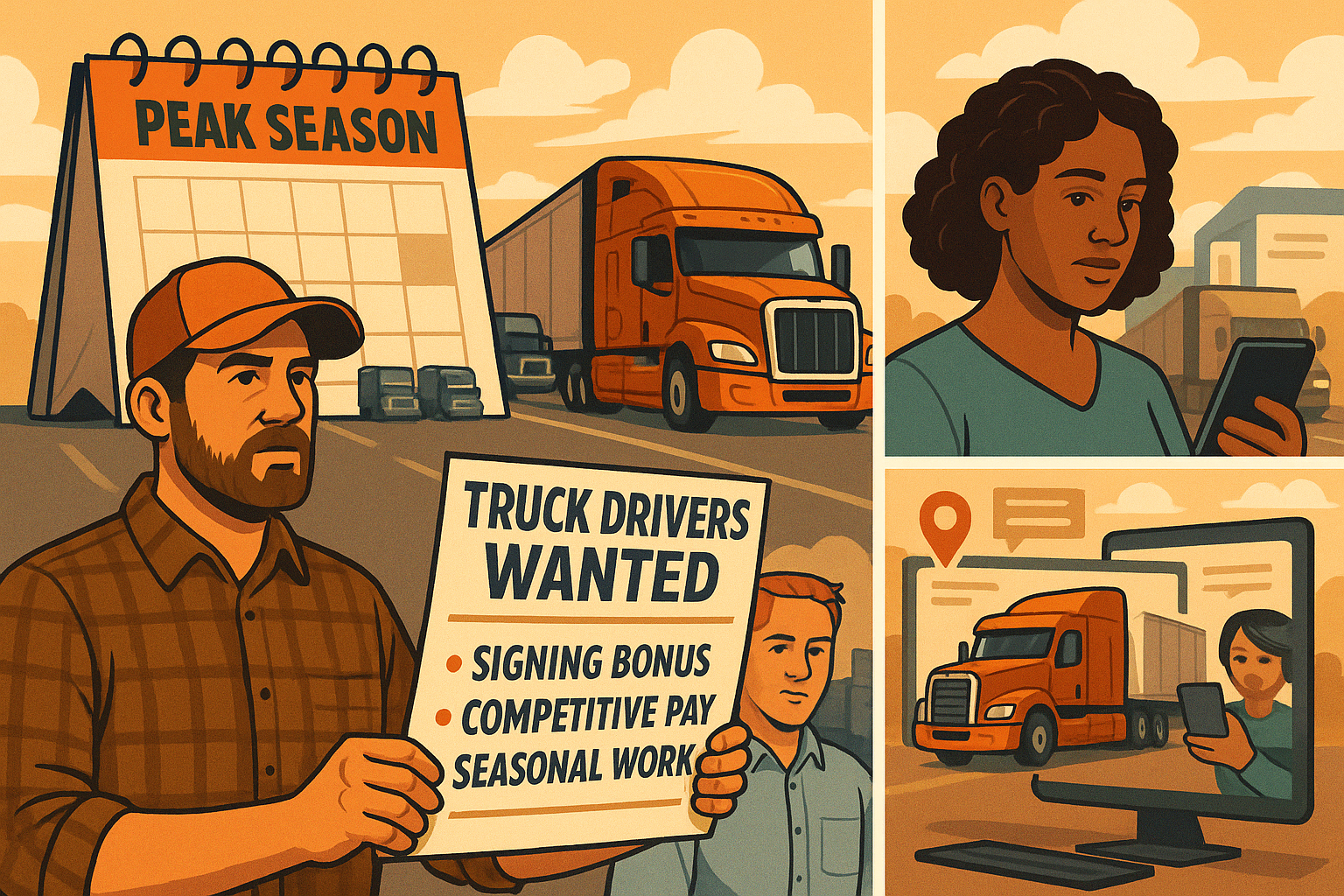In the face of the pressing needs of freight transportation business, one issue keeps coming back every year: the lack of truck drivers for shipping companies during high-volume seasons. In aging times, hard drinks free yearly time, American Thanksgiving, agricultural harvest, or promotional events, idea-growth companies generally find it hard to fill specific demand with qualified drivers. Instead of the Sing-star contest, trucking establishments pick the right couple strategies to celebrate the marriage of new hires and enhance retention rate for successful and long-lasting business performance.
1. Take a Look at the Lock Seasonal Demand and Market Modalities
Above all, the high period for transportation usually means that retailers, manufacturers, and operations all have to hire a truck more than the truckers can offer thus losing the amount of available labor for hired drivers with corresponding skills and time.
What is it all about? Starting the recruitment of truck drivers approximately your way should be: plan for recruitment months beforehand of your main season; self-invest in your organization by making good predictions on the basis of market trends, train people in the correct skills at the appropriate time not to be dramatically late in performing effective marketing against driver burnouts or insufficient driver onboarding?
2. Customize the Job Postings & Messaging to the Shortage Realities
Streamlining recruitment in a tight labor market needs clear and engaging job ads. For some companies, it can be the long-awaited tool to fill empty seats: a good job posting:
- Accentuate the signing bonuses, paychecks above the market average, or flexible working hours.
- Talk about your emphasis on safety, how long they have been there, what grades are going up in the hierarchy, and what are the paths to get there.
- Communicate with “seasonal jobs that can get tenants long-term” so tell them not to worry about seasonal jobs only that will last a short time.
Playing with different kinds of messages like including the fact that there is a serious shortage of qualified truck drivers — in this way, companies will build trust, and also the specialists will react positively to the offer for stable employment.
3. Utilize a Variety of Channels in Recruiting
In times of high demand, it is wise to cast your net wide. A combination of digital and traditional strategies will help you expand your coverage:
| Channel | Strategy Description |
| Job boards & platforms | Post on national and regional boards that specialize in trucking, e.g. Trucking Talent job boards. |
| Social media | Use Facebook groups, LinkedIn, Instagram with stories/photos from your fleet. |
| Referrals | Offer current drivers referral bonuses, word-of-mouth is powerful. |
| Local outreach | Partner with schools, driving academies, employment agencies. |
In the context of jargon, one might say that truckingtalent.com is practically a synonym of a mothership network for the trucking community. It could be leveraged in the messaging: “The collaboration with Trucking Talent helped us get access to a network of skilled drivers who are ready for the peak stretch.” This creates an affinal connection and familiarizes your ideas with the community.
4. Refine the Hiring Process for Speed & Quality
Time never waits. During busy periods, lengthy hiring cycles can cause a lost chance. Here are the tips for a smooth ride:
- Pre-screen candidates via short phone/video interviews before bringing them in.
- Digitize paperwork: Use e-applications and e-signature tools.
- Schedule orientation in batches to onboard more drivers faster.
- Communicate clearly at every step — confirmation emails, SMS reminders, what to bring, what to expect.
The net result: a shorter time to fill positions, lower drop-out rates, and you are able to really schedule the drivers when you need them the most.
5. Offer Flexible and Incentive-Based Compensation
In a demand-critical market, fixed-pay just won’t do. Have a look at other options:
- Bonuses (e.g., more pay per load during the peak weeks X–Y).
- Guaranteed miles or minimum hours with bonus if exceeded.
- Performance incentives, such as safety awards or on-time delivery premiums.
- Flexible scheduling, e.g., shorter runs for those who prefer not to be away long.
These hiring strategies show drivers you value their time and effort — making them more likely to choose your company over competitors.
6. Focus on Retention: Along With Hiring, It’s Keeping Drivers Too
Recruitment is not all that you have to do. Keeping drivers on after peak season is the real ROI. The way to do it includes:
- Be open for conversations after the peak: surveys, feedback, and check-in calls.
- Provide “cool-season” options, such as shorter runs, and training, or reduced schedules.
- Acknowledge and reward loyalty, e.g., by sharing profits at anniversaries or giving time-off bonuses.
- Provide career development: mentoring, leadership training, or clear advancement paths.
The driver which his/her psyche is protected, sees no need to escape and therefore longer stays, which diminishes the churn created by the stress of the high period.
7. Use Partnerships and Non-Traditional Talent Pools
“Traditional” recruiting only scratches the surface. Broaden your reach by:
- Partnering with truck driving schools and community colleges.
- Engaging with veteran transition programs, nonprofits, or veteran driver networks.
- Exploring refugee or immigrant workforce programs, where permitted.
- Considering driver employees from other industries—food delivery, ride-hail, etc. — who may transition.
Eagerly building lines of cooperation can guarantee you do not run out of supply when the peak period comes.
8. Automate Technology to Predict, Manage, and Retain
The power of technology is at your command:
- Route-planning systems predict driver shortages by region and time.
- Applicant-tracking systems (ATS) help manage recruiting flow and communication.
- Retention analytics flag early signs of driver dissatisfaction.
- Automated reminders for license renewals, certifications, or paperwork.
By the introduction of the technological solutions, you will move from passive hiring to planned recruiting, thus making your company more agile when it is time for the peak transportation season.
9. Assemble Culture, Humanity, and a Touch of Technology
The drivers are people. So they like gift respect and want to feel that their effort is recognized and being part of the community. Even though you are busy, have moments to:
- Share driver stories and testimonials.
- Celebrate milestones in newsletters or social media.
- Join community service activities such as charity drives or events that consumers would love to be part of.
These kinds of things (small-touch) can be the only way you to the candidate get known and hired before others present themselves against the same job offer.
10. Assess, Learn, and Progress into the Next Cycle
When the peak time is over, non oh so practical is to stop and introspect:
| Metric | What to Track |
| Time to hire | Days from application to on-road placement |
| Driver turnover rate | Especially during and immediately after peak |
| Cost per hire | Recruiting spend + bonuses ÷ hires |
| Driver satisfaction | Survey scores, qualitative feedback |
| Referral success rate | Number of hires from driver referrals |
Then, put the use of these measurements to best their purpose by following objectives of creating new hiring strategies. Did you try bonuses? Did the channels for outreach bring the best candidates? Did the onboarding take too long? Operating under improvement and adjustment mechanisms that you are mastering, the future peak times will bring you only success.
Conclusion: A Set of Tools for Peak-Time Driver Hiring
Effectively navigating peak shipping time in the trucking business requires the implementation of a multi-faceted, human-centric approach:
- Forecast early and pre-plan hiring.
- Drive yourself with explicitness, honesty, and attractiveness — expressing it over a network like Trucking Talent that you collaborate with.
- Recruit effectively and quickly with flexible systems.
- Reward and keep drivers hired during and after high-demand periods.
- Leverage tech to forecast as well as track both recruitment and retention.
- Metrics should be reviewed post-season and new strategies should be implemented.
With the combination of these techniques, organizations could better deal with driver shortage, win the game in a tough market, and create long-term manpower and driver-centered recruitment ecosystems. It is not just achieving high loaded trucks; but, rather courting, developing, and being true to the clutton that forms the ga[name] of business all year long.










